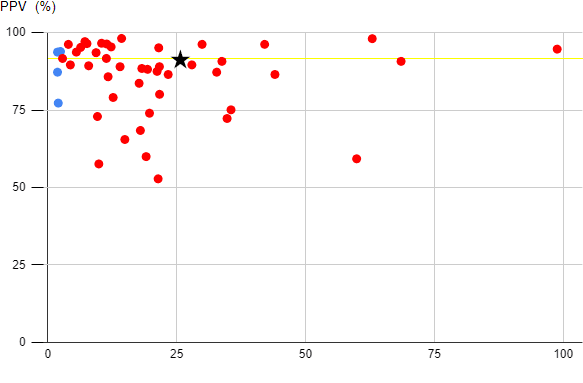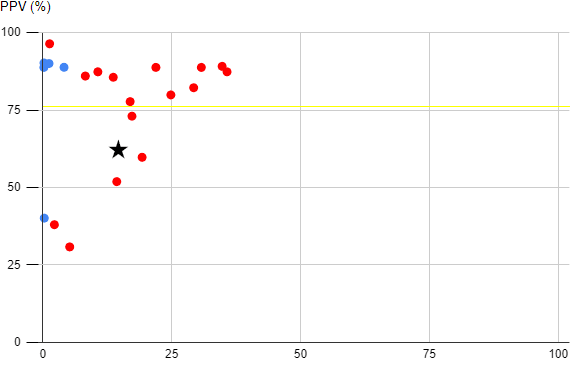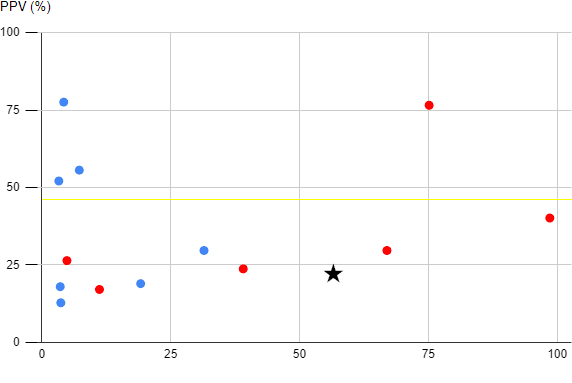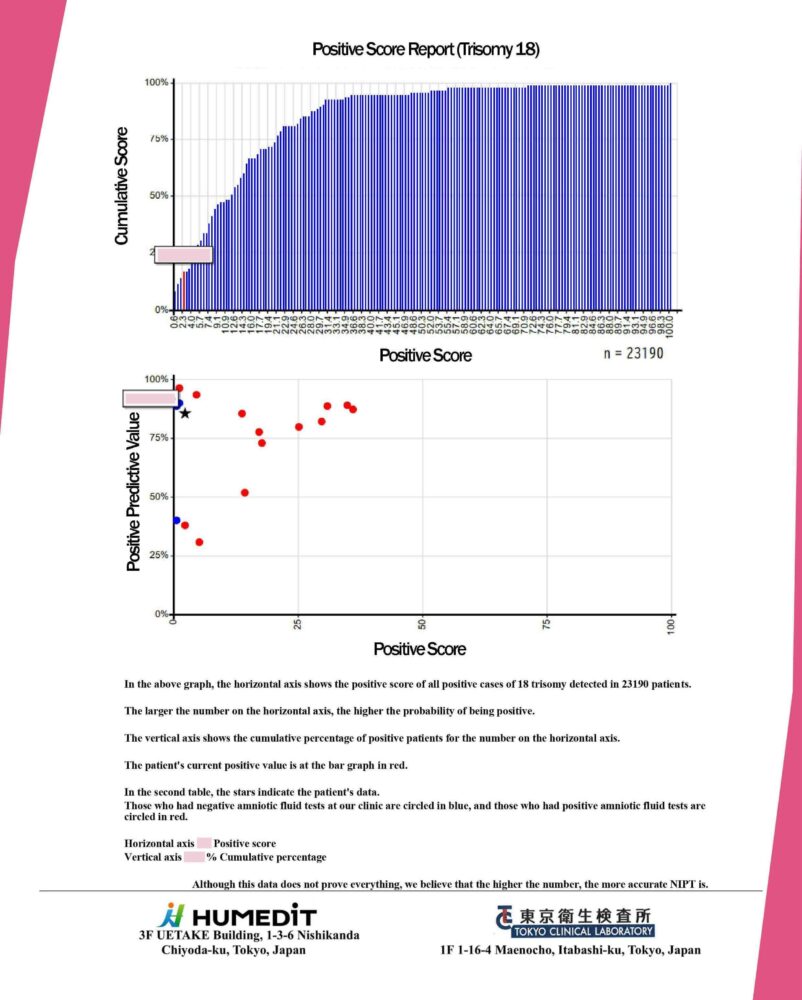When the result turns out to be positive, you will know how positive it really is.
Numerical analysis of amniotic fluid test results
HUMEDIT NIPT is now offering Positivity Score report that provides both “Positivity Score” and ‘Positivity Predictive Rate’ FREE of charge,
that is based on the resutls of over 28,000 NIPT Tests conducted in the clinic.
What is Positivity Score?
Positivity score is a numerical value that measures how far away from the cutoff value that is the borderline between positive and negative results.
The higher the number, the further away from the cutoff value.
By calculating this positivity score, if the test turns out positive, the probability of it being truly positive, to some extent, can be determined even before the amniotic fluid test is performed, and can be used as part of the decision on whether or not to perform the amniotic fluid test.
Cutoff values are Illumina’s reference values for chromosomes 21, 18, and 13, as well as for whole region partial deletions and duplications.
Note: The testing laboratory will only receive negative or positive results if the test is performed at another laboratory as usual. GeneTech and Verinata Healthcare do not provide numerical data other than positive-negative results to medical facilities. Medical institutions cannot obtain information on the degree of positivity even if they inquire about it. (As of January 2021, according to our own research)
Positivity Score Graph
Positivity score for Chromosome 21 Number of cases: 44
June 2020~January 2022

● Amniotic fluid test Positive /
━ Positivity Predictive Value
Positivity score for Chromosome 18 Number of cases: 16
(June 2020~January 2022)

● Amniotic fluid test Positive /
━ Positivity Predictive Value
Positivity score for Chromosome 13 Number of cases: 6
(June 2020~January 2022)

● Amniotic fluid test Positive /
━ Positivity Predictive Value
The three tables above show whether pregnant women whose NIPT test results were positive for Chromosome 21, 18 or 13 trisomy had a positive amniotic fluid test result.
Red dots ● are positive for amniotic fluid test and blue dots ● are negative for amniotic fluid test.
The more dots are on the right on the graph, the higher the positivity score.
Blue dots are more common on the left side (lower positivity scores), indicating a small number of false positives.
Due to the nature of the NIPT test, it can only give positive or negative test results.
We work with the Tokyo Clinical Laboratory to test a large number of patients in order to calculate the positivity score.
We believe that knowing the degree of positivity will help us respond more confidently in the event of a positive test result.
Where your positivity score is on the table is a good indicator
of whether you are truly positive or not.

What is the Positivity Predictive Rate?
The positivivity predictive rate is the probability that a positive diagnosis is indeed positive. The risk of chromosome abnormalities increases in proportion to maternal age, as is well known. Studies have shown that the positive predictive value also increases with maternal age and gestational age.
Furthermore, the positivity predictive rate varies depending on the chromosome being examined.
In other words, from these three factors, it is possible to calculate a pregnant woman’s positivity predictive rate, or the likelihood that a positive diagnosis is indeed positive.
Data from 28,000 (as of November 2022) post-NIPT and amniotic fluid tested pregnant women at HUMEDIT were compiled. The number of patients diagnosed with trisomy 21 by amniotic fluid testing was 30 out of 32 NIPT-positive patients, with a positivity predictive rate of 93.75%. Patients with amniotic fluid testing positive for trisomy 18 were 12 of 16, for a positivity predictive rate of 75%. 3 of 10 patients tested positive for trisomy 13 on amniotic fluid testing, for a positivity predictive rate of 30%.
Everyone says births at older ages are risky because the positivity predictive rate
is determined by the age of the mother and the number of weeks of pregnancy.

Positivity Score Report
The results of the NIPT test are diagnosed as positive or negative based on whether or not each of the values obtained by the test exceeds a reference value called the ‘cutoff value’.
However, if the positive result is obtained at a value just above the cutoff value, the possibility of being negative is, of course, very high.
On the other hand, the positivity predictive rate is also determined by age, number of weeks of pregnancy, and chromosomes to be examined, and if the positivity predictive rate is higher even if it is closer to the cut-off value, it is more likely to be true when diagnosed positive.
NIPT is a non-definitive test, and while we recommend an amniotic fluid test as a definitive test if your NIPT result turns positive, many people are skeptical about whether to take an amniotic fluid test.
The positivity score and the positivity predictive rate can be used to determine where you are at in the process of deciding whether or not you should have an amniotic fluid test.
Positivity score reports are only included for positive results for chromosome 21 trisomy, chromosome 18 trisomy, and chromosome 13 trisomy.

Just because the test result is positive does not mean
you have to arrange for an amniotic fluid test right away.
Wait until you see the positivity score report before you think about it.

Knowing the positivity score is very helpful in the following situation:
Pregnant women around 40 years old
When the gestational age is 40 years or older, the positivity predictive rate is 93% or higher.
As mentioned earlier, this number is calculated from the number of weeks of pregnancy and the mother’s age before the test is performed.
For example, for a 40-year-old pregnant woman with a 10-week pregnancy, the positive predictive rate for chromosome 21 trisomy is 93.87%.
A one-digit positivity score for this pregnant woman may be negative enough, so we strongly recommend waiting until the number of weeks when amniotic fluid testing is available and then making a decision after the amniotic fluid test.
Positivity score reports are recommended for:
In some cases, a high positivity score is all it takes to give up.
If it is positive, the positivity score can be used to determine whether an amniotic fluid test should be taken.
Positivity score reports are provided free of charge with all plans that include testing for abnormalities in the number of chromosomes 21, 18, and 13.
※ Full Set Plan, Recommended Plan, over35 Plan, Light Plan, Minimum Plan, Chromosome 21 Stand-alone test, Chromosome 18 Stand-alone test and Chromosome 13 stand-alone test.




